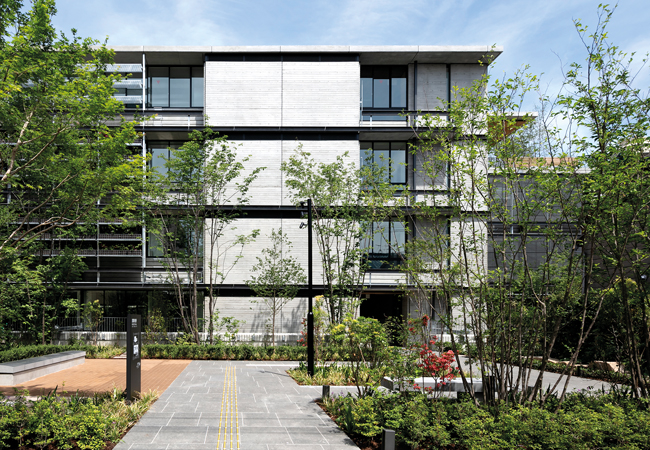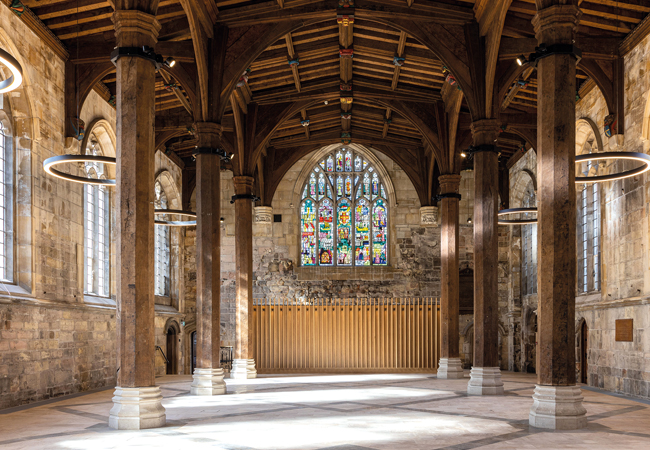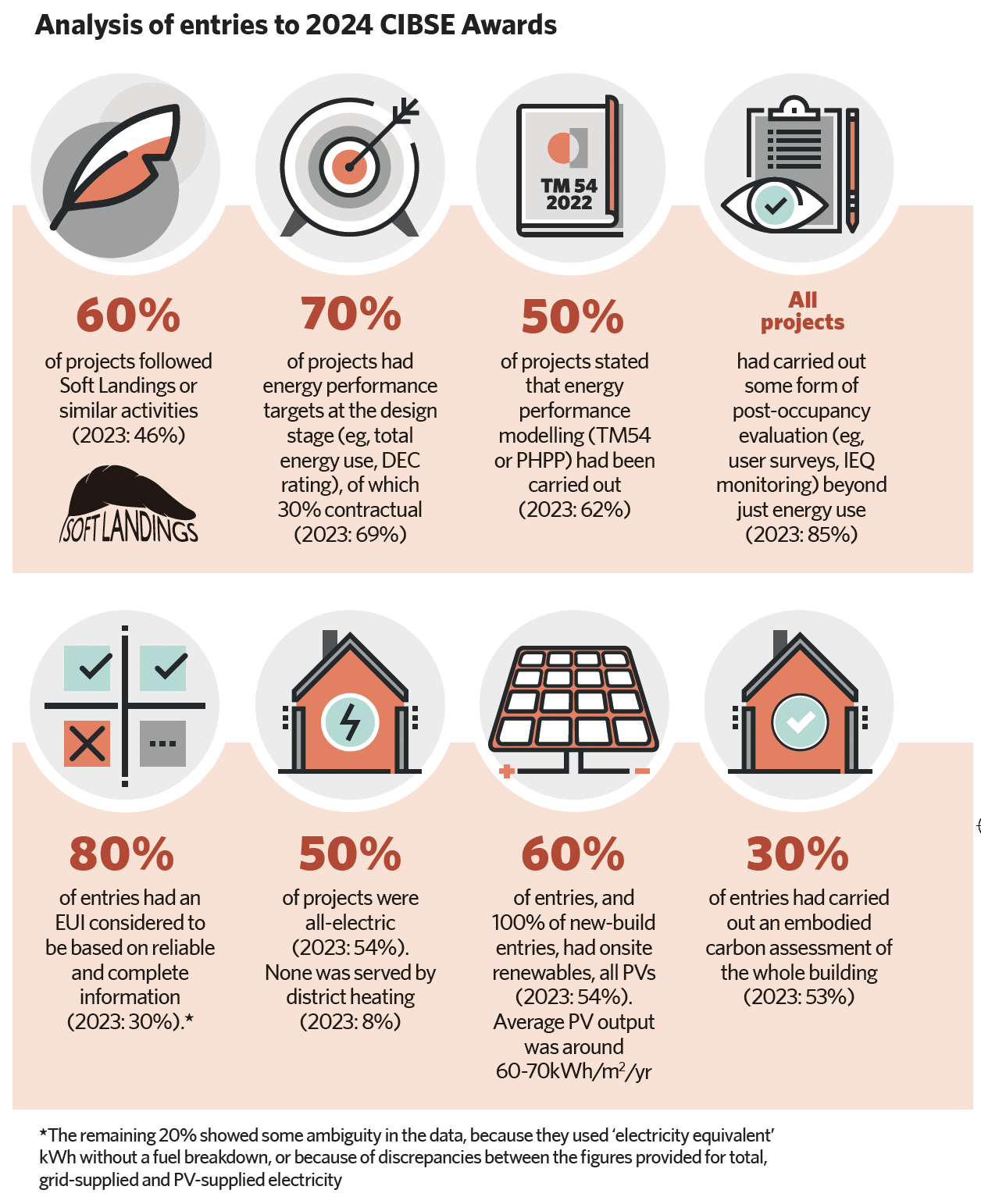
Kyoto City Hall Annex Building is CIBSE’s current International Project of the Year
Entries for the 2025 CIBSE Building Performance Awards are open. The categories and criteria have been informed by CIBSE’s analysis of last year’s entries, in order to reflect and reward continuous industry development.
As in the past few years, CIBSE has reviewed last year’s awards entries to assess building performance across the projects, as well as the quality of the information provided.
In 2021, based on a review of all past entries, CIBSE introduced a data form to accompany the Project of the Year entries, to improve the consistency, quality and coverage of the building performance data provided.
This helps the judging process, and contributes to industry’s understanding of current best practice, in turn feeding into CIBSE activities such as the Net Zero Carbon Buildings Standard (NZCBS).
Since then, entries have been reviewed every year, and updates made to the data forms to reflect evolving practice and improve clarity and data collection.
Key changes for entries to 2025 Awards
Two new categories have been introduced:
- Client of the Year, to recognise the crucial role of clients in driving whole life building performance. These are open to clients from the public or private sector, for entry by nomination by consultants, contractors or other parts of the client’s supply chain.
- Leadership, to recognise organisations, initiatives and individuals that have demonstrated exceptional leadership in climate action, whether towards net zero and/or climate adaptation. This does not have to apply to a specific building project and could include, for example, non-profit organisations or local authorities demonstrating exemplar action in these areas.
The Digital Innovation awards have been split into two categories – Project Delivery and Organisational Change – to reward the wide variety of entries received in this dynamic field.
Other changes are relatively small. For example, the Project of the Year sectors have been reorganised to better align with commonly used categorisation in industry and with the sectors of the upcoming Net Zero Carbon Buildings Standard.
Deadline for entry is the 30 August. To enter visit www.cibse.org/bpa
Quality of data
This year’s analysis confirms that the quality and scope of building performance data continues to increase. The award entries show fewer areas of data uncertainty, more consistent information, and wider coverage of building performance.
While a large proportion of buildings entered into the awards have onsite generation, the energy flows associated with the building and onsite systems are better reported than in previous years. This indicates better metering set-ups, as well as better monitoring and analysis.

SGA Consulting was crowned CIBSE Building Performance Champion for its retrofit of York Guildhall
In recent years, few entries had complete and reliable enough data to estimate the building’s energy use intensity (EUI) with reasonable confidence, but, importantly, this is now possible for the majority of entries.
What the data tell us

Last year’s data shows trends in delivery processes applied across the projects, similar to previous years. As expected, projects often used energy performance modelling (rather than just compliance modelling) – for example, Passive House Planning Package (PHPP) or CIBSE TM54 more generally. Many of them set energy performance targets beyond regulatory compliance, sometimes as contractual targets. They carried out post-occupancy evaluation, with attention to energy use as well as factors beyond it, such as indoor air quality, temperature monitoring, and interviews or surveys of occupants.
The new-build entries had lower energy use than the average building stock, sometimes significantly so; however, energy use was still higher than industry targets from the RIBA 2030 Challenge and LETI for the sectors where these targets are most established, such as homes, offices and schools.
For the majority of entries, the data is reliable and complete enough to estimate the building’s energy use intensity
In future years, the NZCBS, due for beta release later this year, will provide a further point of comparison, applicable across a wide range of sectors.
The majority of projects, and all the new-build ones, had onsite photovoltaics (PVs) – in some cases with significant export as well as self-use. The contribution of these PV systems varied significantly across projects, on average around 60-70kWh/m2 per yr building footprint (ranging from 35 to 140), covering, on average, around 30% of the building’s annual energy use (ranging from 5% to 55%).
For comparison, in last year’s Technical Update Consultation, the NZCBS proposed an approximate target range of 80-120kWh/m2 per yr for non-industrial buildings; this was only a draft and is being reviewed ahead of the beta release.
CIBSE looks forward to your entries, and wishes you all the best of luck!
Project of the year: changes to the data-collection forms
Changes have been made to this year’s data-collection forms, which have to be submitted for Project of the Year entries. These changes include:
- More information on refrigerants impact, including global warming potential (GWP) and charge, and prompting information on in-use leakage if known. This reflects increasing industry and regulators’ attention to the impact of refrigerants, and increased penetration of heat pumps and cooling.
- Where there is onsite generation, the building footprint area should be provided. This will allow clearer comparisons across projects during the judging process. It will also allow benchmarking against emerging NZCBS targets for onsite renewable generation, which are currently proposed to be in kWh/yr/m2 of building footprint.
- Modified language for reporting on batteries, to reduce uncertainty and to differentiate energy that transits through the battery but is, ultimately, used by the building, is lost in storage, and stored (on annual basis).
- More specific information on embodied carbon assessments – eg, stages covered and compliance, or not, with the RICS Professional Statement on Whole Life Carbon: this reflects industry development. The CIBSE awards apply to projects with at least one year of operation, so there is a necessary time lag from the design stages. In previous years, the data forms only asked for relatively basic information because embodied carbon assessments were still uncommon and less standardised.
- Water consumption now in the Essential tab, to reflect increased pressures on water supplies, particularly in the South East. It will also help gather data on total operational carbon, not just from energy use. Several project entrants reported on it in previous years.
- More information on peak demand, now in the Essential tab. Again, this reflects increased attention to demand management as buildings electrify, and helps provide a more rounded view of building performance, as well as contributing to future benchmarks and targets.
As always, if information is not available, entrants have the option to simply say so. This does not prevent entry or disqualify projects.
To enter visit www.cibse.org/bpa
